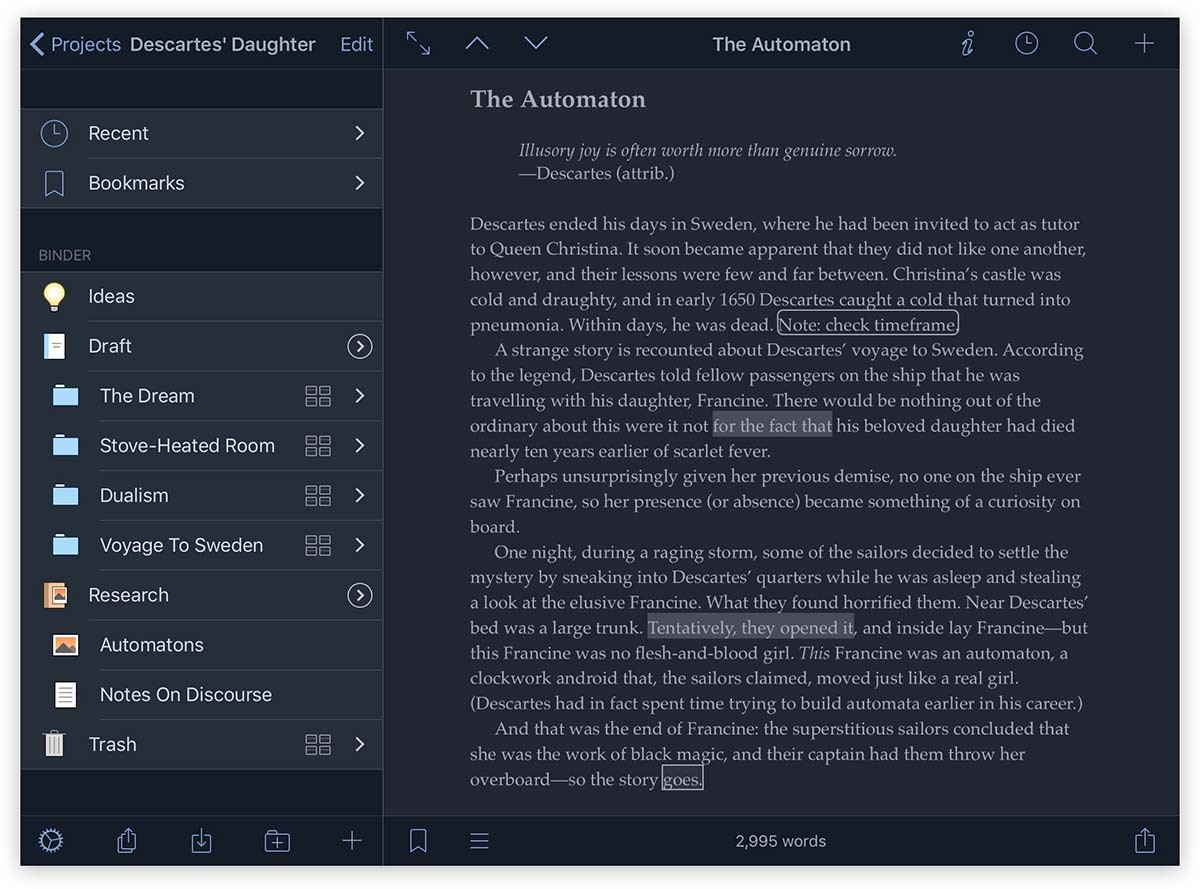

No matter how you do it, if you write with Scrivener you’ll need to plan on preparing the file with another program. That could mean using Word or moving on to more complex layouts using InDesign or Affinity Publisher. If you’re an independent author and you’re publishing yourself, you will need another program to do the page layout. The “Compile” command provides some options about formatting and file type, but I find it easiest to export as a basic DOCX file and work in MS Word to perform the layout and design.Īnd therein lies the one flaw with Scrivener. This, like most features of Scrivener, is relatively easy and painless. Once you’ve prepared the manuscript, you’ll need to compile it into a single file and select the file type to export. You can write a short description or piece of reminder text for each scene or section, then organize the corkboard to your liking. The most useful feature of the corkboard is the ability to add a synopsis to each element. It’s called the “corkboard” and it allows authors to organize different pieces within the binder, to begin piecing together the manuscript. Scrivener offers one more cool way to organize and prepare your writing. Your work will be more consisten in the early drafts, aiding in the editing process later. Having important and useful information that close to hand not only saves time and gets you back to writing more quickly, but it also fosters good research and crafting habits. Then click back to the scene you were writing and carry on! Writing a scene with a secondary character you thought up a month ago? Forgot how you imagined them appearing? No worries, just expand the Character folder, click on the Character Sketch template you created. Once you learn the ins and outs of Scrivener, you’ll find that creating custom folders and templates helps to keep your background work quickly accessible. Add images, video, audio, and text files you think may be useful in writing your manuscript. Create templates to organize your research into coherent and easily referenced files. They nest all the content into easily organized folders. We manage the binder with a column on the left. Your project is essentially a three-ring binder, and you’ve got dividers and labeled sections, with the various pieces stored in the correct locations. They call the project a “binder” and envisioning it this way can help clarify how it works. When you work in Scrivener, you’re not writing a single file, you’re working within a project. Finally, I would need theme and character trait research documents.īy the time I finished a piece, the folder for that manuscript would be massive and often needlessly confusing.

And research about the location(s) based on the setting of the story.

I’d also need a shortlist of info for secondary characters.

For a nonfiction piece, this would compromise source material, reference links, and a file with quotes copied in and sourced.įor fiction, I would create a character worksheet for every main character. Often the number of individual research files would exceed twenty. This included at least one file for the main body of the work, an outline, a timeline, and research files. Or more recently, I will do the same in my Google Drive with multiple documents in a single folder. Organization.īefore I encountered Scrivener, I would create a file folder on my desktop, then generate a multitude of Word files and save them in this folder. Scrivener brings with it one more compelling reason to use it as your primary word processor. The shift in focus is obvious with Scrivener’s session goals, allowing you to plan a word count target for your writing sessions. I recommend diving right in and doing some writing before you set up a template and the font/style to get a feel for the word processor. It only takes a session of writing to realize why Scrivener excels at this. Sit down, limber up your fingers, and let the words pour out. Scrivener is the most versatile writing and research tool I’ve ever encountered.
SCRIVENER LITERATURE AND LATTE SOFTWARE
The utility Scrivener offers, coupled with the clean, no-nonsense word processor, will appeal to writers of all sorts.Īs an added benefit, the software stores your files through a Dropbox link, meaning you can work on your content across multiple machines, and even with an iOS app on your iPhone or iPad. Many common features (page sizing, margins, font control) are present and allow you to play with some layouts, but the real power of Scrivener is in organizing your ideas and generating the initial content. Using a ‘Binder’ to contain all elements in one easily navigable location, Scrivener sets a new standard for writing software. Rather than offering an all-in-one writing and layout tool, Scrivener is laser-focused on research, storyboarding, and writing. Scrivener is a writing-focused tool developed by Literature & Latte.


 0 kommentar(er)
0 kommentar(er)
